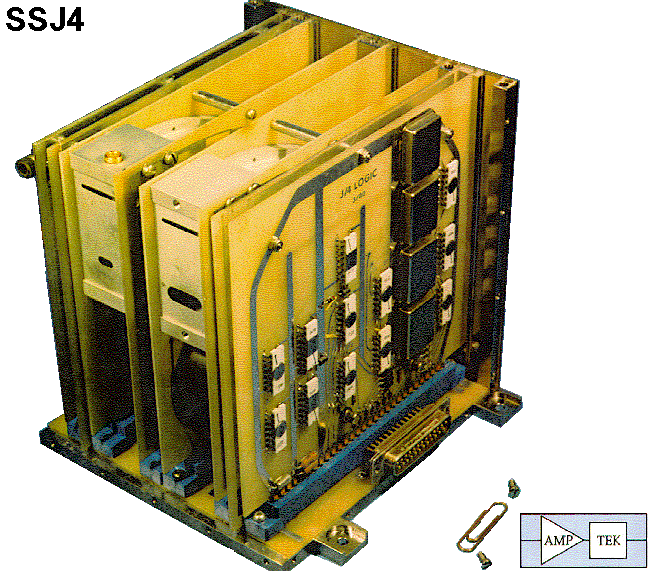
The SSJ4 detector flown on spacecraft of the DMSP series from Flight 6 (F6) to F15 measure the flux of precipitating electrons and ions in the range of 30 keV to 30 eV. The measurements are made by 4 detectors, one high energy detector and one low energy detector for the each of the particle types. The ion detectors do not have any mass discrimination. Each detector has 10 logarithmically spaced energy steps. The high energy detectors step from 30 keV to 1 keV and the low energy detectors step from 1 keV to 30 eV. The last step of the high energy detector is set at the same energy as the first step of the low energy detector in order to cross-calibrate the detectors. The particle fluxes are measured within a solid angle of 2° by 5° for the high energy channels and 4° by 5° for the low energy channels centered on local vertical. Each detector has a pair of cylindrical curved plates which electrostatically deflect the particles as they pass from the aperture to the detector. Only particles within an energy band of approximately 10% of the channel step energy will be able to freely pass from the aperture to the detector. The curved plates of the high (low) detectors have a radius of curvature 60° (127°). Each detector has a dwell time of 0.098 sec and a 0.002 sec period between steps to stabilize the voltage. Each detector make a complete 10 step sequence in 1 second. One 20 point ion and one 20 point electron is returned once per second. Actually the spectra have only 19 points becuase of the redundancy of the 1 keV energy step.
Both the ion and electron detectors employ post-accelerations (100 V for the electrons and 1 kV for the ions). The ion and electron units are identical except that the polarity of the voltage that is applied to the cylindrical plates. The total SSJ4 instrument weights 5 lbs (2.3 kg) and consumes 0.25 W of power.
The figure below show the SSJ4 sensor with its outer cover removed. Each pair of detectors is a modular unit for rapid removal and insertion into the unit.

The detector elements which can be contaminated by hydrocarbons in the air are replaced approximately 4 weeks before launch. This change-out procedure has allowed the detectors to work for 3 - 5 years in orbit without a significantly decrease in efficiency.
CALIBRATION
The SSJ4 detectors are calibrated with an electron beam system in a vacuum chamber at AFRL/RVBX. The calibration system consists of an illumination system (UV souce), a photocathode (quartz substarte coated with a thin film of gold), a high voltage supply system and gimbal tables. The UV system is configured to provide nearly uniform illumination of the photocathode. The UV light penetrates the gold film generating photoelectrons at the gold/vacuum interface. A negative potential is applied to the photcathode sets up an electric field between the photocathode fram and a ground wire screen in front of the cathode. The photoelectrons are accelerated by this field and pass through the screen, forming a nearly monoenenergetic, uniform electron beam with about a 15 cm radius. The beam is tunable in energy from approximately 10 V to 50 kV. The entire system is contained within a set of Helmholtz coils used to cancel out the Earth's magnetic field.
The calibration of each SSJ4 instrument is different. Users should never use an old calibration on a new data set. Also, after an SSJ4 instrument has been in orbit for several years, the calibration may change due to a decrease in efficiency of the detector elements. Users should always check with personnel at AFRL/RVBX before using the raw SSJ4 data.
SPACECRAFT CHARGING
The connecting wires between elements of the solar panel are exposed to the space environment and are positively charged. This causes the DMSP spacecraft to be charged 10 - 30 V negatively whenever the spacecraft is in sunlight. This often causes thermal ions to get into the 30 eV ion channel and sometimes into the 45 eV ion channel. Users should be aware of this problem when looking at the low energy ion data.